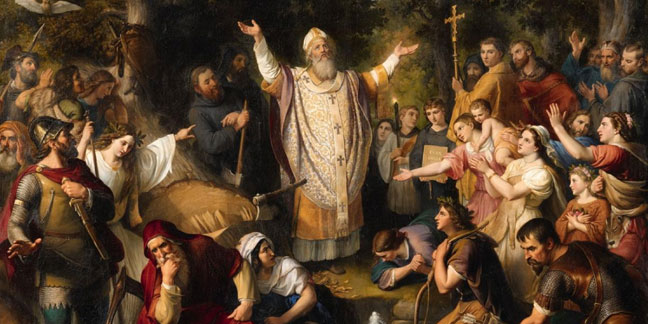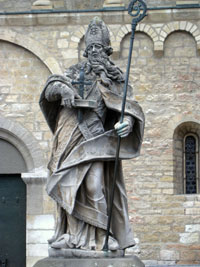 St. Boniface was very bold in his faith, and he was well known for being very good at using the local customs and culture of the day to bring people to Christ.
St. Boniface was very bold in his faith, and he was well known for being very good at using the local customs and culture of the day to bring people to Christ.
St. Boniface was born as Wynfrid – also written as Wynfrith, Winfrid or Winfrith – sometime around the year 675 in Wessex (present-day Devon), England. Overcoming the initial disapproval of his Anglo-Saxon family, he was able to pursue a career in the Church. He was educated at Benedictine monasteries (first Exeter, then Nursling), and became an ordained priest at the approximate age of 30.
Instead of remaining in England, Wynfrid decided to became a missionary. In 716, he traveled to Frisia (now part of The Netherlands), following in the footsteps of other Anglo-Saxon missionaries. However, he found the local ruler unwelcoming and soon left the area.
After his return to England, Wynfrid was chosen to be the abbot of his monastery. Still wishing to evangelize, he turned down the position and proceeded to Rome in 718. There, he met with Pope Gregory II, who gave him the name Boniface.
On May 15, 719, the pope sanctioned Boniface’s desire to spread the Gospel. Boniface once again visited Frisia, where the political climate had changed. This allowed him to gain valuable experience as a missionary, which he then put to use in Hesse.
In 722, Boniface was made a bishop. He soon received the protection of Charles Martel, the Carolingian ruler of the Franks. His path made easier by this protection, Boniface returned to missionary work.
One story about St. Boniface tells about when he met a tribe in Saxony that was worshipping a Norse deity in the form of a huge oak tree. Boniface walked up to the tree, removed his shirt, took an ax, and without a word, chopped it down. Then he stood on the trunk, and asked: “How stands your mighty god? My God is stronger than he.” Conversions followed when its worshipers saw that Boniface was not immediately punished for his actions.
 Boniface focused on Thuringia (part of present-day Germany) from 725 to 735. He received the pallium in 732, which made him an archbishop and gave him the ability “to consecrate bishops wherever the faithful have increased.” As his proselytizing took effect, Boniface also did his best to stem any heresies he encountered. He applied the same zeal to his next task, that of organizing the Church in Bavaria.
Boniface focused on Thuringia (part of present-day Germany) from 725 to 735. He received the pallium in 732, which made him an archbishop and gave him the ability “to consecrate bishops wherever the faithful have increased.” As his proselytizing took effect, Boniface also did his best to stem any heresies he encountered. He applied the same zeal to his next task, that of organizing the Church in Bavaria.
After their father’s death, Boniface coordinated with Carloman and Pepin, Martel’s sons, over Church reforms. This resulted in Frankish clergy growing closer to Rome. Boniface, whom Pope Zachary had named the archbishop of Mainz, also may have crowned Pepin III as king in 751. Whether or not Boniface oversaw the coronation, he had laid the groundwork for papal authority to influence religious and political development in a large swath of Europe in the coming years.
After returning to missionary work, he was martyred on June 5, 754, while on mission in Holland, where a group of pagans attacked and killed him and his 52 companions. His body was taken to the monastery at Fulda, which he had founded in 744.
St. Boniface, deemed the “apostle to the Germans,” is regarded as the patron saint of brewers and tailors, as well as of Germany.
— Biography.com, Catholic News Agency
On June 27, Roman Catholics will honor St. Cyril of Alexandria. An Egyptian bishop and theologian, he is best known for his role in the Council of Ephesus, where the Church confirmed that Christ is both God and man in one person. The Eastern churches celebrate St. Cyril of Alexandria on June 9.
Cyril was most likely born in Alexandria, the metropolis of ancient Egypt, between 370 and 380. From his writings, it appears he received a solid literary and theological education. Along with his uncle, Patriarch Theophilus of Alexandria, he played a role in an early fifth-century dispute between the Egyptian and Greek churches. There is evidence he may have been a monk before becoming a bishop.
When Theophilus died in 412, Cyril was chosen to succeed him at the head of the Egyptian Church. He continued his uncle's policy of insisting on Alexandria's preeminence within the Church over Constantinople, despite the political prominence of the imperial capital. The two Eastern churches eventually re-established communion in approximately 418.
Ten years later, however, a theological dispute caused a new break between Alexandria and Constantinople. Cyril's reputation as a theologian, and later Doctor of the Church, arose from his defense of Catholic orthodoxy during this time.
In 428, a monk named Nestorius became the new Patriarch of Constantinople. It became clear that Nestorius was not willing to use the term "Mother of God" ("Theotokos") to describe the Virgin Mary. Instead, he insisted on the term "Mother of Christ" ("Christotokos").
During the fourth century, the Greek Church had already held two ecumenical councils to confirm Christ's eternal preexistence as God prior to his incarnation as a man. From this perennial belief, it followed logically that Mary was the mother of God. Veneration of Mary as "Theotokos" confirmed the doctrine of the incarnation, and Christ's status as equal to the God the Father.
Nestorius insisted that he, too, held these doctrines. But to Cyril, and many others, his refusal to acknowledge Mary as the Mother of God seemed to reveal a heretical view of Christ which would split him into two united but distinct persons: one fully human and born of Mary, the other fully divine and not subject to birth or death.
Cyril responded to this heretical tendency first through a series of letters to Nestorius (which are still in existence and studied today), then through an appeal to the Pope, and finally through the summoning of an ecumenical council in 431. Cyril presided over this council, stating that he was "filling the place of the most holy and blessed Archbishop of the Roman Church," Pope Celestine, who had authorized it.
The council was a tumultuous affair. Patriarch John of Antioch, a friend of Nestorius, came to the city and convened a rival council which sought to condemn and depose Cyril. Tension between the advocates of Cyril and Nestorius erupted into physical violence at times, and both parties sought to convince the emperor in Constantinople to back their position.
During the council, which ran from June 22 to July 31 of the year 431, Cyril brilliantly defended the orthodox belief in Christ as a single eternally divine person who also became incarnate as a man. The council condemned Nestorius, who was deposed as patriarch and later suffered exile. Cyril, however, reconciled with John and many of the other Antiochian theologians who once supported Nestorius.
St. Cyril of Alexandria died on June 27, 444, having been a bishop for nearly 32 years. Long celebrated as a saint, particularly in the Eastern Catholic and Eastern Orthodox churches, he was declared a Doctor of the Church in 1883.
— Catholic News Agency

